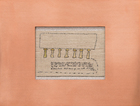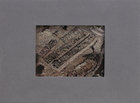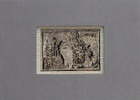Nalgures (Someplace) situates us in an indeterminacy that is yet to be defined, within certain fragmentary geographies: places, vestiges, modes of occupation. Narelle Jubelin (Sydney, 1960) examines the memories of certain spaces, of certain specific objectual and literary references within the Galician setting, which link up with other cartographies and with references to her own biography and artistic career. This happens, for example, in a calligraphic intervention in which Jubelin interprets A desvertebra, a text by the poet, Ana Romani (Noia, Corunna, 1962). Moreover, for this project, for the first time, Jubelin incorporates other contemporary artistic creations into her semantics; such is the case of the photographs taken by Anna Turbau (Barcelona, 1949) in Galicia in the mid nineteen-seventies and which hint at elements to which the Australian artist resorts decades later.
Nalgures delves into the memory of the landscape and of human habitation constructions, but also into the modes of spatial occupation and the formal redefinition of different cultural productions. The new works, produced specifically for this exhibition, are joined by elements present in previous projects, such as Soft Shoulder (Art Gallery of Western Australia, Perth, 1997), Shumakom (Artists’ House, Jerusalem, 2002), Afterimage (La Casa Encendida, Madrid, 2012), Plants and Plants (Fundação Calouste Gulbenkian, Lisbon, 2013), Floor and Wall (ABM, Madrid, 2018), Primitive Road (Nordeste, Santiago de Compostela, 2018) or The Housing Question (Penrith Regional Gallery, Sydney, 2019).
As a starting point, the CGAC itself, located at one end of Bonaval Park where the presence of water articulates this site of a former convent, which in turn is linked to the intensity of the architecture of a defunct cemetery. The proximity of the main route of pilgrimage to Compostela, the French Way, links up with the location of water architectures that catch Jubelin’s attention. One of these is the laundry house in Pinisqueira (Aguiño, Ribeira, Corunna), located by the sea in a place near to the A Orixe Way, the latest of the pilgrimage routes articulated around the translatio of the Apostle's body from Jerusalem. It was precisely in this city, during the second Intifada in 2002, where Jubelin exhibited Shumakom, a project in which she examined conflict and occupation. Hence the reference in Nalgures to the Gaza Strip, and in particular to the spatial layout of one of the refugee camps, before and after the bombing on 25 July, in the context of the Israeli offensive in the summer of 2014.
In Shumakom we encountered the fusion of two voices of different origins—Hebrew and Arabic—an encounter that could be translated as ‘no place.’ From this indeterminacy, from this absence of place, we take a position in nalgures: in some place. Thus, we remain in indeterminacy, now, practicable and passable. As Georges Didi-Huberman wrote, ‘To take a stance is to desire, it is to demand something, it is placing oneself in the present and aspiring to a future.’


































